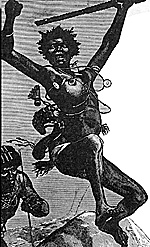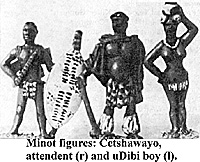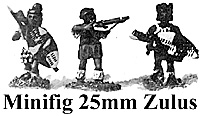 EDlTOR'S NOTE: Ian Knight is editor of Soldiers of
the Queen, the bulletin of the Victorian Military Society.
Published 12 times a year, this publication is to Colonial
gaming what Slingshot is to ancient gaming.
EDlTOR'S NOTE: Ian Knight is editor of Soldiers of
the Queen, the bulletin of the Victorian Military Society.
Published 12 times a year, this publication is to Colonial
gaming what Slingshot is to ancient gaming.
Ian, whose expertise is the Zulu War, is our Theme Editor in this Zulu War Centennial year. Ian will be providing many articles and article ideas for this period throughout the year.
When building up a collection of figures to represent the Zulu army on the wargame table, the player is faced with several questions concerning Zulu firepower: how many guns did the Zulus possess? How well did they use them? Did the presence of guns in large numbers affect Zulu tactical thinking in any way, and how can this best be represented in the game?
The answer to the first of these questions at least, may come as something of a surprise. It is difficult to be sure about a great many aspects concerning the Zulu army before its demise at the battle of Ulundi in July 1879, but what evidence there is suggests that there were far more guns in Zulu hands than is generally supposed.
By 1879 the Zulus were no stranger to the firearm. They had first experienced them in the early 1820's when a group of white traders visited the court of King Shaka. Although the inevitable musketry display had a suitably awe- inspiring effect on his subjects, Shaka, though interested, was less impressed.
He was justifiably proud of his own military machine, and argued that speed, discipline and numbers would be enough to give his warriors the edge. It was a theory not put to I the test until the latter days of the reign of his successor, Dingane, during the war against the Boer Voortrekkers. The Boer victory at Blood River where a handful of Boers successfully defended a laager, or circle of wagons, against overwhelming Zulu numbers, is well known and generally held up as an example of the innate superiority of the gun over the assegai.
It is worth mentioning however, that in two previous incidents in the campaign the Zulus had ambushed Boer and British forces, exploited their weaknesses, broken their formations and routed them -- guns or no.
 Indeed, the first guns to come into Zulu hands
were probably trophies looted from vanquished
Voortrekkers. In the years following Dingane's defeat and
the succession of his weak-willed but peacefully minded
halfbrother umPande, trade between the growing colony of
Natal and the Zulus flourished. Gun running was generally
frowned upon since most colonists were well aware of the
threat posed by the Zulu army should relations suddenly
deteriorate, but it unquestionably went on.
Indeed, the first guns to come into Zulu hands
were probably trophies looted from vanquished
Voortrekkers. In the years following Dingane's defeat and
the succession of his weak-willed but peacefully minded
halfbrother umPande, trade between the growing colony of
Natal and the Zulus flourished. Gun running was generally
frowned upon since most colonists were well aware of the
threat posed by the Zulu army should relations suddenly
deteriorate, but it unquestionably went on.
Filtering In
In addition, small quantities of guns probably filtered into the country through the usual tribal grapevine: a man is given a gun for working in the gold fields, he gives it to his son, who gives it to his cousin, who sells it to his friend who happens to be a Zulu...and so on.
The Portugese whose colony Mozambique lay to the north of Zululand, had fewer scruples about arming the natives. The Vice Consul estimated that between 1875 and 1877 an annual average of 20,000 guns (with percussion caps), 500 breech loaders and 10,000 barrels of powder passed through the port destined for the native trade. Two thirds of this went to the Zulus. Another source puts the figure at 10,000 in 1877.
These figures may be exaggerations; an official British report in 1878 estimated that there were scarcely 8,000 guns in Zululand at that time. It is significant however, that the price of firearms in Zululand dropped sharply in the years preceding the war, a sure indication that they were in plentiful supply. At the beginning of Cetshwayo's reign, a double-barrelled muzzle-loader cost four head of cattle or 20 Pounds, but by 1879 it could only fetch one beast.
Even the Enfield, until recently government issue, could be bought for one sheep, and old Tower and 'Prussian' muskets cost as little as 7s 6d. Powder, too, seems to have been in plentiful supply. It was widely believed in Natal that Cetshwayo had a sizable arsenal, and the inDuna Dabulamanzi claimed his warriors had enough powder to keep them supplied for several years of prolonged campaigning. Bullets were the only problem, but the warriors had no qualms about using pebbles as substitutes for lead "slugs".
If the Zulus had guns, how well did they use them? Sadly, this answer is less encouraging. Many of the guns were not the best quality to start with, and the warriors probably did not look after them very well.
Drilling Zulus
In Natal it was said that British deserters had been drilling the Zulus in musketry, but had made little headway in their efforts, because the warriors could not grasp the principles of range, sights and windage.
The story may have been pure rumor, but it does illustrate the problem. Both the Zulus and later the Matabele (who went to war with Cecil Rhodes' British South Africa Company in 1893 with considerably better weapons than their Zulu counterparts) believed that the higher a gun was aimed the further it would shoot. Most Zulu fire was therefore high, and it is no coincidence that in 1879 most of the bullets passed over the heads of their targets, only to drop the occasional unsuspecting mounted officer!
Many warriors, too, were wary of the recoil and held the butt away from their shoulder, bracing it instead against the hip or even the ground. Descriptions of the Matabele war speak of warriors trying to fire a gun whilst holding a shield in the hand that gripped the forestock -- I've tried that particular trick, and can assure you that it is difficult enough to hold a shield at arm's length with the left hand, let alone trying to steady a gun with it as well!
So what was the effect of a large number of guns in the ranks combined with an almost total ineptitude in using them have on the Zulu tactical outlook? The short answer is: very little. Most warriors were highly conservative in their outlook -- the traditional "beasts horns" tactic had made their forefathers masters of Southern Africa -- they saw no reason to change it now. Since it was designed purely to enable as many warriors to close within stabbing distance as quickly as possible, it took no account of the long-range possibilities offered by guns.
 Warriors could carry guns into battle if they
liked, but surely a true man chose to kill his enemy
face to face, not shoot him down from a safe
distance like a coward? It was an attitude that
relegated the firearm to the position of a purely
secondary weapon. Certainly guns were used widely
in the 1879 war (one witness at Isandhlwana going so
far as to say "The Zulus nearly all had some kind of
firearm, and plenty of ammunition"), but incidentally to
their main weapon which was still the assegai.
Warriors could carry guns into battle if they
liked, but surely a true man chose to kill his enemy
face to face, not shoot him down from a safe
distance like a coward? It was an attitude that
relegated the firearm to the position of a purely
secondary weapon. Certainly guns were used widely
in the 1879 war (one witness at Isandhlwana going so
far as to say "The Zulus nearly all had some kind of
firearm, and plenty of ammunition"), but incidentally to
their main weapon which was still the assegai.
It is significant that most accounts mention Zulu fire increasing as the charges faltered -- deprived of the opportunity to close, the warriors then sat back and opened fire. Similarly, when they were not present in large enough numbers to risk a rush across open ground, the warriors harrassed enemy patrols with rifle fire, a surprisingly effective tactic of which more might have been made.
More Negative Effects
There were two more negative effects that guns might be said to have had on their Zulu owners. Familiarity to some extent had bred contempt, and most warriors tended to judge others by their own woeful standards. As the Zulus were pretty hopeless with guns themselves, they expected this to be the case generally, and were not prepared for the appalling effects that controlled volley fire had upon them.
Though the warriors triumphed at Isandhlwana (and incidentally, added several thousand more guns to their own stock), it raised the first doubts as to their invulnerability. The tide of victory carried them into action at Kambula, but the dreadful volleys blasted them to a standstill and finally broke their spirit. It is interesting that the warriors used their own rifles to a greater extent at Kambula than at any other battle. This was probably due in part to the new weapons (from Isandhlwana) in their possession, partly to the fact that they were pinned down and could retaliate no other way.
Finally, it is generally recognized that in the 1893 Matabele war the Matabele sacrificed some of their much vaunted mobility by carrying guns both by continually stopping to aim, fire and load, and through the extra weight. Though it has not been mentioned in connection with the Zulu war, it seems highly likely to have had a similar effect, though perhaps not to so great a degree.
So in deciding the proportion of gunmen to include in his Zulu ranks, the wargamer must remember to include quite a few, but not to over- emphasize them in his rules. A Zulu with a gun, it has been said, was merely a Zulu without an assegai, and generally a blessing to his enemy.
Sources
A very useful feature on firearms and the Zulu can be found in the Journal of African History Vol. Xll No. 4 1971. Eye-witness descriptions of volume and effect of Zulu fire can be found in The Red Soldier by Frank Emery (Hodder and Stoughton, 1978). A great many more useful facts can be gleaned by a careful perusal of contemporary accounts such as Cornelius Vjin's Cetshwayo's Dutchman and John Dunn's Cetshwayo and the Three Generals, both published about 1881, and rather difficult to get hold of now, I'm afraid.
Related
-
Zulu Firepower
Zulu Army Organization
Zulu Weapons and Uniforms
Native Levies in the Zulu War
Imperial Infantry Uniforms of the Zulu War
Zulu Roundup: Figures and Books
Back to Table of Contents -- Courier Vol. 1 #1
To Courier List of Issues
To MagWeb Master Magazine List
© Copyright 1979 by The Courier Publishing Company.
This article appears in MagWeb (Magazine Web) on the Internet World Wide Web.
Other military history articles and gaming articles are available at http://www.magweb.com